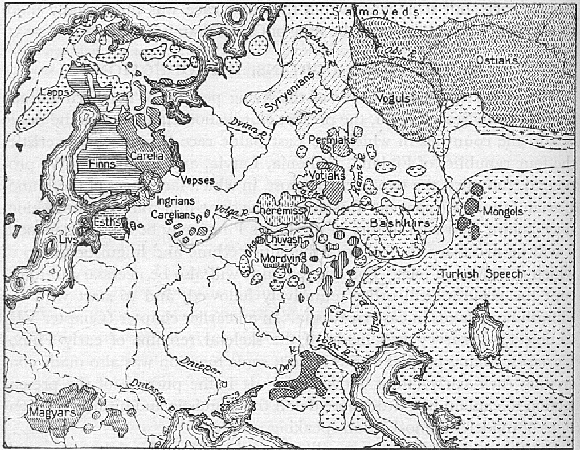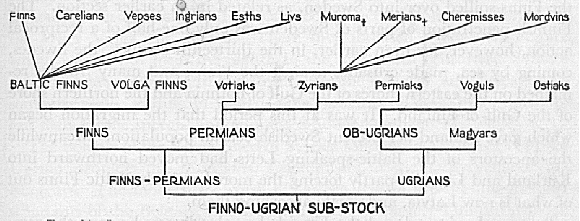|
(Chapter IX, section 8)
The Finno-Ugrians, introduction
For the sake of clarity, we will repeat that Finno-Ugrian, along with Samoyedic, forms the Uralic linguistic stock or sub-stock which may or may not be united with Turkic, Tungusic, and Mongolian in a Ural-Altaic superstock. It is now believed that early Finno-Ugriain was one of the two elements which blended to form basic Indo-European.68 Although today their use is not as extensive as that of Indo-European, modern Finno-Ugrian languages are by no means archaic, and show no tendency toward disappearance. They are, in fact, spoken by a large number of peoples, living under extremely variable environmental and cultural conditions, and scattered over a wide expanse of territory. In three nations, Finland, Esthonia, and Hungary, divisions of Finno-Ugrian are the official languages, spoken by millions of people. In western Siberia, as well as in these Countries, Finno-Ugrian speech occupies a large space on the map, but in this wilderness of forest and swamp it is actually spoken by very few persons. Elsewhere, throughout eastern central Russia and thence in a narrow band across to the mouth of the Gulf of Finland, it is found in little islands standing out in the midst of Slavic territory. |

THE DISTRIBUTION OF URALIC AND ALTAIC SPEECH ON EUROPEAN SOIL.
|
This does not include Osmanli Turkish as spoken in the former Turkish Empire. All Turkish speech is represented by crescents, Mongols by cross-hatching, and Samoyedic by small circles. Finno-Ugrian is represented by various types of lines and stipple; except for Lappish, which is indicated by crosses, and livonian, which is solid. The northern instances of Carelian are Kvaenish. Linguistic affiliations within the stock may best be illustrated by Kajava's chart, reproduced in slightly altered form below.69 In this chart the term Ingrians is used to include the various groups of Finnic speakers native to the Leningrad region; namely, the Vodes, the Lyds or Ijores, and the two tribes called Evremeiset and Savakot, who live among Russians in the city of Leningrad itself.70 The early home of the united Finno-Ugrians is supposed by linguists to have been in the region which extends from the headwaters of the Dnieper and the western Dvina to the western slope of the Ural Mountains. The country around the Oka, the bend of the Volga, and the Kama are thought to have been occupied by Finno-Ugrians by the time that some of their southeastern tribes mingled with Caucasic-speaking peoples to produce Indo-European. |

Fig. 31. LINGUSISTIC RELATIONSHIPS OF FINNO-UGRIAN SPEAKING PEOPLES. After Kajava, Y., EA #8, #9, 1922, pp. 353-358.
|
In their early home, during the first millennium B.C.,71 the Finns were in contact, on their southern flank, with the Scythians, who lived west of the Don, and with the Sarmatians, who occupied the plains to the east of it. Baltic peoples seem to have touched them on the west, for Baltic words are in use among Mordvins, who have never been near the sea. In the time of the earliest Greek accounts, Finns seem to have occupied all of the country which stretched from the Polessje district of White Russia to the central and lower reaches of the Volga. Herodotus located a people called Budinoi in the eastern part of this region, presumably in the Volga country; west of them he placed the Androphagoi, then the Melancheles (Black Mantles), and in the very west, the Neuroi. The name Androphagoi or Cannibals, has the same meaning as the Iranian word Mord-Chvar, whence are derived Mordva and our own term, Mordvin. The black mantle to which Herodotus referred is still a part of the national costume of the Volga Finns. During the centuries immediately preceding the Christian era, the ancestors of the Baltic Finns migrated westward from their original home to the eastern shore of the Baltic, south of the Gulf of Finland, where they occupied the country north of the Düna and the northern half; at least, of Kurland, thus taking over most of what is now Latvia, as well as Esthonia. After the beginning of the Christian era, some of them crossed the Gulf of Finland and settled near Abo and in the Kokemaki and Kyrö valleys of the present Finland. This country was already inhabited by an Iron Age population, of Scandinavian cultural affinity, which the Finns completely absorbed. The invaders gradually spread eastward until, about 700 A.D., they reached the present Carelia. Thence they went to southern Savo, which seems to have been permanently occupied by 1000 A.D. From there on the occupation of Finland spread gradually northward until eventually the Finns spilled over into Sweden, as related in an earlier section. The Finnish penetration of parts of Sweden was only one-half of a reciprocal action, however, for even earlier, in the thirteenth century, the Swedes, coming by sea, made crusades against the Finns, and many Swedes remained on the eastern shores of the Gulf of Bothnia and the northern shore of the Gulf of Finland. It was at this period that the migration began which gave Finland her present Swedish coastal population. Meanwhile the ancestors of the Baltic-speaking Letts had moved northward into Kurland and Livonia, partly forcing the more southerly Baltic Finns out of what is now Latvia, and partly absorbing them. Between Leningrad and the Finnish homeland may be seen the remnants of the early migrant groups, who, when the Slavs first appeared, between the sixth and eighth centuries A.D., formed a continuous belt of Finnish-speaking peoples. Nearest the Gulf are the Vodes and Ijores, and the Leningrad tribes; on the shores of Lake Onega and the headwaters of the Oyat River live the Vepses, who formerly possessed a large territory and were a powerful people well into Slavic times. To the south and east of the Vepses lived the Merians, now linguistically extinct, who covered the territory between the Oka and the upper Volga. Farther south and east lived the now equally extinct Muroma, and then various tribes of Cheremisses, and finally the Mordvins. The connecting links between the Vepses and the Cheremisses have disappeared, and the groups that have survived have suffered great losses of territory. The position of the Carelians in this picture is not quite clear; it is known, however, that they had settled the shores of the White Sea as early as 900 A.D., and were later largely dislodged by Russians. They are linguistically a branch of the Baltic Finns most closely related to the Esthonians, but it is not known whether they ever were actually in Esthonia, or if so, whether they moved northward across the Gulf of Finland with the Finns, or around its eastern end. In any case, the Carelians now living in Ingria and the Volga country seem to represent a secondary infiltration from the present Carelia rather than an early survival.
Although the departure of the ancestors of the Baltic Finns from their Volga homelands took place so early that the movements of the central Asiatic nomads did not affect them directly, these incursions were responsible for other Finno-Ugrian migrations. In the first century A.D., the Huns entered the Volga country and remained along its lower and middle course until after having routed the Ostrogoths, when they went on to the present Hungary. In the fifth century, after their misadventure in France, the Huns returned to the Don Basin and joined their relatives the Bolgars, who had come from the region of the Ural and Kuban Rivers in southeastern Russia, and had settled between Finns and Ugrians on the lower Volga and Kama. There they founded a powerful empire, which was to last from the eighth to the fourteenth centuries. Some of these Bolgars migrated to the lower Danube country and defeated the southern Slavs, settling in what is now Bulgaria. These Bulgarians later lost their Uralic speech, and adopted a Slavic language.
Under Turkish leaders a large body of Ugri left this region and migrated to the southern steppes, whence in the ninth century they moved to Hungary, and mixed with the remnants of the Huns and Avars who dwelt there. These Ugri became the Magyars, the modern Hungarians, whose language is still basically Ugrian, modified by much Turkish influence. The Finno-Ugrians today include peoples in every stage of culture from hunting and fishing to that of modern civilized states. They are held together by a bond of language and by a certain modicum of old cultural traits, particularly those concerned with music and poetry, with which high and low cultural levels fail to inteffere. Although aggressively persistent on the peripheries of their radius of migration, they have become recessive in the center of it, where the great surges of invasion and of empire from central Asia, and the subsequent steady and irresistible expansion of the eastern Slavs, have reduced their cultural survivors to a minimum, while their physical survivors, since they form an important element in the composition of modern Russia, are much more numerous. In view of their history the Finno-Ugrians are a much more important factor in the building of eastern Europe than their present numbers would, on the sufface, indicate. 67. Useftil sources are: 68. See Chapter VI, sections 1 and 8, Chapter VII, sections 1 and 3. 69. Kajava, Y., EA, #8, #9, 1922, pp.353-358.
70.The Ijores number roughly 11,000, the Vodes about 700. Exact figures for the Evremeiset and Savakot have not been obtained. 71. The chief source for the following historical résumé is Bunak, V., ZFMA, vol. 30, 1932, pp. 441-503. |